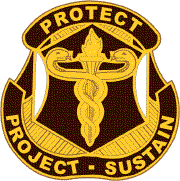United States Army Medical Research and Development Command
U.S. Army command for medical research and development
The United States Army Medical Research and Development Command (USAMRDC) is a major command of the United States Army responsible for medical research and development. It plays a critical role in ensuring the health and readiness of the U.S. military forces by advancing medical science and technology.
History[edit | edit source]
The USAMRDC was established to consolidate the Army's medical research efforts and to provide a unified command structure for medical research and development. Over the years, it has evolved to address emerging medical challenges and to incorporate new scientific advancements.
Mission[edit | edit source]
The primary mission of the USAMRDC is to provide medical solutions to protect and sustain the health of military personnel. This includes developing vaccines, treatments, and medical devices that address the unique needs of soldiers in various operational environments.
Structure[edit | edit source]
The USAMRDC is organized into several subordinate commands and laboratories, each focusing on specific areas of medical research. These include:
- U.S. Army Medical Research Institute of Infectious Diseases (USAMRIID)
- Walter Reed Army Institute of Research (WRAIR)
- U.S. Army Institute of Surgical Research (USAISR)
Research Areas[edit | edit source]
The command's research areas are diverse and include infectious diseases, combat casualty care, military operational medicine, and medical chemical and biological defense. The USAMRDC collaborates with other military, governmental, and civilian organizations to advance its research objectives.
Key Achievements[edit | edit source]
The USAMRDC has been instrumental in developing vaccines for diseases such as Ebola and Zika virus. It has also contributed to advancements in trauma care and the development of protective equipment for soldiers.
Future Directions[edit | edit source]
Looking forward, the USAMRDC aims to leverage emerging technologies such as artificial intelligence and genomics to enhance its research capabilities. The command is also focused on improving the rapid deployment of medical solutions in response to new threats.
Related pages[edit | edit source]
Transform your life with W8MD's budget GLP1 injections from $125
W8MD offers a medical weight loss program NYC and a clinic to lose weight in Philadelphia. Our W8MD's physician supervised medical weight loss centers in NYC provides expert medical guidance, and offers telemedicine options for convenience.
Why choose W8MD?
- Comprehensive care with FDA-approved weight loss medications including:
- loss injections in NYC both generic and brand names:
- weight loss medications including Phentermine, Qsymia, Diethylpropion etc.
- Accept most insurances for visits or discounted self pay cost.
- Generic weight loss injections starting from just $125.00 for the starting dose
- In person weight loss NYC and telemedicine medical weight loss options in New York city available
- Budget GLP1 weight loss injections in NYC starting from $125.00 biweekly with insurance!
Book Your Appointment
Start your NYC weight loss journey today at our NYC medical weight loss, and Philadelphia medical weight loss Call (718)946-5500 for NY and 215 676 2334 for PA
Search WikiMD
Ad.Tired of being Overweight? Try W8MD's NYC physician weight loss.
Semaglutide (Ozempic / Wegovy and Tirzepatide (Mounjaro / Zepbound) available. Call 718 946 5500.
Advertise on WikiMD
|
WikiMD's Wellness Encyclopedia |
| Let Food Be Thy Medicine Medicine Thy Food - Hippocrates |
Translate this page: - East Asian
中文,
日本,
한국어,
South Asian
हिन्दी,
தமிழ்,
తెలుగు,
Urdu,
ಕನ್ನಡ,
Southeast Asian
Indonesian,
Vietnamese,
Thai,
မြန်မာဘာသာ,
বাংলা
European
español,
Deutsch,
français,
Greek,
português do Brasil,
polski,
română,
русский,
Nederlands,
norsk,
svenska,
suomi,
Italian
Middle Eastern & African
عربى,
Turkish,
Persian,
Hebrew,
Afrikaans,
isiZulu,
Kiswahili,
Other
Bulgarian,
Hungarian,
Czech,
Swedish,
മലയാളം,
मराठी,
ਪੰਜਾਬੀ,
ગુજરાતી,
Portuguese,
Ukrainian
Medical Disclaimer: WikiMD is not a substitute for professional medical advice. The information on WikiMD is provided as an information resource only, may be incorrect, outdated or misleading, and is not to be used or relied on for any diagnostic or treatment purposes. Please consult your health care provider before making any healthcare decisions or for guidance about a specific medical condition. WikiMD expressly disclaims responsibility, and shall have no liability, for any damages, loss, injury, or liability whatsoever suffered as a result of your reliance on the information contained in this site. By visiting this site you agree to the foregoing terms and conditions, which may from time to time be changed or supplemented by WikiMD. If you do not agree to the foregoing terms and conditions, you should not enter or use this site. See full disclaimer.
Credits:Most images are courtesy of Wikimedia commons, and templates, categories Wikipedia, licensed under CC BY SA or similar.
Contributors: Prab R. Tumpati, MD




